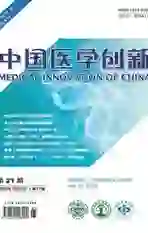姜黄素通过NF-κB信号通路发挥对S16细胞的保护作用
2020-11-06王宏宇王淑萍贾永明刘得水陈刚
王宏宇 王淑萍 贾永明 刘得水 陈刚


【摘要】 目的:探討姜黄素对受阿霉素神经毒性损害的S16细胞(大鼠施万细胞)的保护作用,并分析其作用的分子机制。方法:以正常培养的S16细胞培养基作为对照组,以400 ng/mL阿霉素刺激S16细胞培养基作为阿霉素组,阿霉素组中含100 μg/mL姜黄素的培养基作为姜黄素组。采用噻唑蓝(MTT)实验与Western Blot测定并比较三组S16细胞增殖情况与Caspase-8凋亡蛋白相对含量;利用酶联免疫吸附实验(ELISA)测定并比较三组NF-κB、肿瘤坏死因子-α(TNF-α)与超氧化物歧化酶(SOD)表达量。结果:阿霉素组OD值为(0.82±0.21),比对照组的(1.84±0.16)降低(t=13.33,P<0.01);姜黄素组OD值为(1.19±0.14),比阿霉素组升高(t=5.08,P<0.01)。阿霉素组Caspase-8凋亡蛋白相对含量为(37.14±0.02),比对照组的(8.93±0.04)升高(t=1 524.54,P<0.01);姜黄素组Caspase-8凋亡蛋白相对含量为(24.62±0.07),比阿霉素组降低(t=504.17,P<0.01),姜黄素组NF-κB与SOD含量均高于阿霉素组(t=184.54、52.36,P<0.01),姜黄素组TNF-α含量低于阿霉素组(t=64.49,P<0.01)。结论:姜黄素通过NF-κB信号通路保护受阿霉素神经毒性损害的S16细胞。姜黄素与阿霉素联合应用可以降低阿霉素产生的神经毒性副作用,是比较有前途的肿瘤化疗抗副作用药物。
【关键词】 姜黄素 S16细胞 阿霉素 NF-κB信号通路
[Abstract] Objective: To investigate the protective effect of Curcumin on S16 cells (Schwann cells in rats) damaged by Adriamycin neurotoxicity, and to analyze its molecular mechanism. Method: The normal S16 cell culture medium was used as the control group, 400 ng/mL Adriamycin stimulated S16 cell culture medium was used as the Adriamycin group, and the 100 μg/mL Curcumin medium in the Adriamycin group was used as the Curcumin group. The proliferation of S16 cells and the relative content of caspase-8 apoptosis protein among three groups were measured and compared by Thiazoline-blue (MTT) experiment and Western blot. The expression of NF-κB, tumor necrosis factor-α (TNF-α) and superoxide dismutase (SOD) among three groups were measured and compared by enzyme-linked immunosorbent assay (ELISA). Result: The OD value of the Adriamycin group was (0.82±0.21), it was lower than (1.84±0.16) of the control group (t=13.33, P<0.01). The OD value of the Curcumin group was (1.19±0.14), it was higher than that of the Adriamycin group (t=5.08, P<0.01). The relative content of the Caspase-8 apoptosis protein in the Adriamycin group was (37.14±0.02), it was higher than (8.93±0.04) in the control group (t=1 524.54, P<0.01). The relative content of Caspase-8 apoptosis protein in the Curcumin group was (24.62±0.07), it was lower than that in the Adriamycin group (t=504.17, P<0.01). The content of NF-κB and SOD in the Curcumin group were higher than those in the Adriamycin group (t=184.54, 52.36, P<0.01). The content of TNF-α in the Curcumin group was lower than that in the Adriamycin group (t=64.49, P<0.01). Conclusion: Curcumin protects S16 cell damaged by Adriamycin neurotoxicity through the NF-κB signaling pathway. Curcumin combined with Doxorubicin can reduce the neurotoxic side effects of Doxorubicin and is a promising anti-side effect drug for tumor chemotherapy.
姜黃类植物中提取的姜黄素属于低毒而多效的多酚类小分子化合物,具有较好的抗炎、抗氧化、清除氧自由基等药理作用;能够对抗多种肿瘤,对神经精神系统疾病具有较好的保护作用,具有抑制阿霉素产生氧自由基的理论作用[5]。
本实验为了研究姜黄素对阿霉素产生的神经纤维脱髓鞘的抑制作用,以大鼠S16施旺细胞为研究对象,分为对照组、阿霉素组及姜黄素组。利用MTT实验发现,阿霉素组OD值为(0.82±0.21),比对照组的(1.84±0.16)降低(t=13.33,P<0.01),说明S16细胞在阿霉素的作用下其增殖能力显著降低,这可能是由于阿霉素对细胞具有较强的毒性作用。Bober等[10]研究发现阿霉素会产生阿霉素半醌自由基,并将其电子进一步传递给氧,在下游生产超氧阴离子和过氧化氢,这些化学物质再经过铁离子催化产生羟自由基,自由基的高表达会阻断细胞内能量代谢、物质代谢过程。2017年,Huun等[11]研究阿霉素的毒性作用发现,阿霉素会增加氧自由基生成而损伤细胞内的呼吸链酶系统、线粒体呼吸链传递系统,加重线粒体损伤,能量减少则会抑制细胞有丝分裂、细胞周期延长等细胞增殖降低的表现。
为了验证阿霉素对S16细胞凋亡的作用,Western Blot实验发现,阿霉素组Caspase-8凋亡蛋白相对含量比对照组升高(t=1 524.54,P<0.01)。说明阿霉素组Caspase-8凋亡蛋白明显高表达,与Huun等[11]研究结果相一致,即阿霉素诱发产生大量氧自由基、导致细胞能量减少会加重细胞出现凋亡、坏死等现象[11]。在阿霉素组中添加了姜黄素后,姜黄素组Caspase-8凋亡蛋白相对含量比阿霉素组降低(t=504.17,P<0.01),Anand等[12]认为姜黄素对NF-κB、STAT3、HIF-1、MMPs、iNOS、ATP酶等多种蛋白酶具有分子靶点,并能够激活转化生长因子(epidermal growth factor,EGF)、肝细胞生长因子(hepatocyte growth factor,HGF)、神经生长因子(nerve growth factor,NGF)、血小板生长因子(platelet growth factor,PDGF)等多种蛋白激酶。研究发现,以上激酶对细胞的生长、增殖等保护作用非常重要,并发现姜黄素能够调控NF-κB信号通路,有效对抗神经炎症和氧化应激的作用,减少神经细胞凋亡,与本研究结果一致[5]。
大量体外和体内实验表明,姜黄素可以抑制细胞内生成TNF-α[13]。神经组织中TNF-α持续高水平表达,会导致神经元的兴奋性神经递质谷氨酸持续性释放而引起兴奋性神经毒性,神经元内环境稳态被破坏和突触间信号传递障碍[14]。TNF-α还会通过激活p38-MAPK信号通路增加神经递质5-HT的再摄取,导致5-HT在突触间隙含量下降[15],因此推测,TNF-α对阿霉素产生的神经脱髓鞘等严重副作用具有比较重要意义,本实验发现姜黄素组TNF-α含量低于阿霉素组(P<0.05)。姜黄素具有良好的保护S16细胞作用,可能也是通过抑制TNF-α的生成而发挥作用的,但是也不排除姜黄素通过其他分子机制发挥作用。
综上所述,姜黄素通过NF-κB通路保护受阿霉素神经毒性损害的S16细胞。姜黄素与阿霉素联合应用可以降低阿霉素产生的神经毒性副作用,是比较有前途的肿瘤化疗抗副作用药物。
参考文献
[1] Tang Q,Wang Y,Ma L,et al.Peiminine serves as an adriamycin chemosensitizer in gastric cancer by modulating the EGFR/FAK pathway[J].Oncology Reports,2018,39(3):1299-1305.
[2] Luo P,Zhu Y,Chen M,et al.HMGB1 contributes to adriamycin-induced cardiotoxicity via up-regulating autophagy[J].Toxicology Letters,2018,292:115-122.
[3] Hoshi R,Watanabe Y,Ishizuka Y,et al.Depletion of TFAP2E attenuates adriamycin-mediated apoptosis in human neuroblastoma cells[J].Oncology Reports,2017,37(4):2459-2464.
[4] Doggui S,Belkacemi A,Paka G D,et al.Curcumin protects neuronal-like cells against acrolein by restoring Akt and redox signaling pathways[J].Mol Nutr Food Res,2013,57(9):1660-1670.
[5] Dai C,Ciccotosto G D,Cappai R,et al.Curcumin Attenuates Colistin-Induced Neurotoxicity in N2a Cells via Anti-inflammatory Activity,Suppression of Oxidative Stress,and Apoptosis[J].Mol Neurobiol,2018,55(1):421-434
[6]陈小雨,高飞,钱永常.姜黄素在肿瘤治疗中的应用机制[J].临床合理用药杂志,2019,12(9):181-182.
[7] Klippstein R,Bansal S S,Al-Jamal K T.Doxorubicin enhances curcumins cytotoxicity in human prostate cancer cells in vitro by enhancing its cellular uptake[J].Int J Pharm,2016,514(1),169-175.
[8] Savitz J,Harrison N A.Interoception and Inflammation in Psychiatric Disorders[J].Bmc Cell Biology,2018,3(6):514-524
[9] Liu X,Cao W,Qi J,et al.Leonurine ameliorates adriamycin-induced podocyte injury via suppression of oxidative stress[J].Free Radic Res,2018,52(9):952-960.
[10] Bober P,Alexovic M,Talian I,et al.Proteomic analysis of the vitamin C effect on the doxorubicin cytotoxicity in the MCF-7 breast cancer cell line[J].J Cancer Res Clinical Oncology,2017,143(1):35-42.
[11] Huun J,Gansmo L B,Manns?ker B,et al.Impact of the MDM2 splice-variants MDM2-A,MDM2-B and MDM2-C on cytotoxic stress response in breast cancer cells[J].Bmc Cell Biology,2017,18(1):17.
[12] Anand P,Sundaram C,Jhurani S,et al.Curcumin and cancer:an“old-age”disease with an“age-old”solution[J].Cancer Lett,2008,267(1):133-164.
[13] Sahebkar A,Cicero A F,Simental-Mendia L E,et al.Curcumin downregulates human tumor necrosis factor-alpha levels:A systematic review and meta-analysis ofrandomized controlled trials[J].Pharmacol Res,2016,107:234-242.
[14] K?hler C A,Freitas T H,Maes M,et al.Peripheral cytokine and chemokine alterations in depression:a meta-analysis of 82 studies[J].Acta Psychiat Scand,2017,135(5):373-387.
[15] Jiao J T,Sun J,Ma J F,et al.Relationship between inflammatory cytokines and risk of depression,and effect of depression on the prognosis of high grade glioma patients[J].J Neurooncol,2017,124(3):475-484.
(收稿日期:2019-12-04) (本文編辑:田婧)
